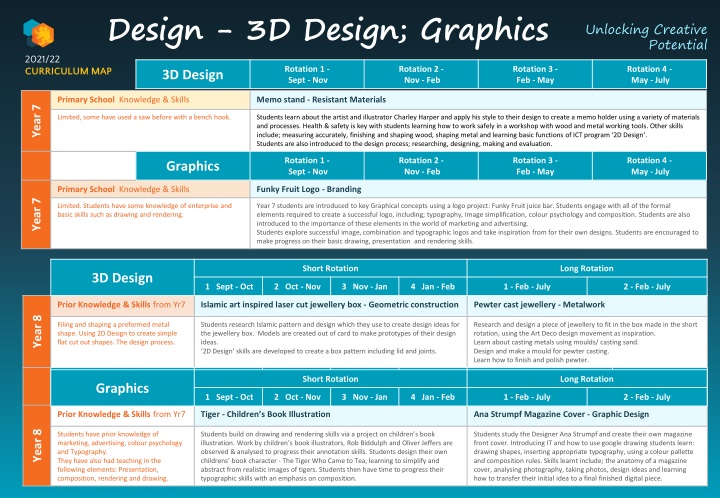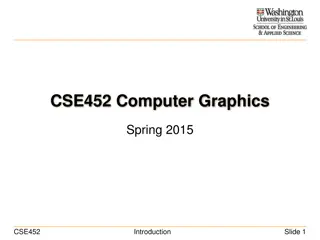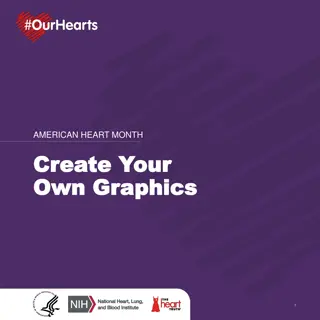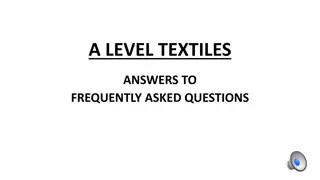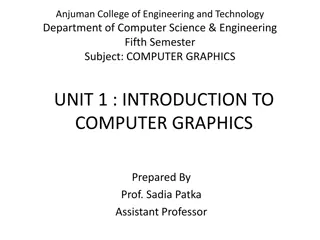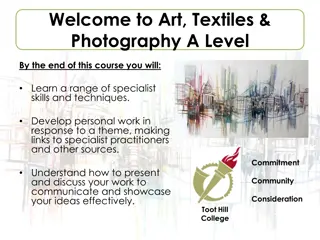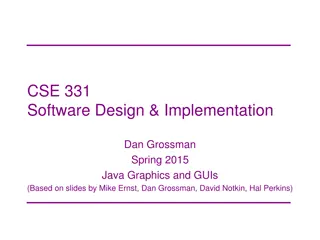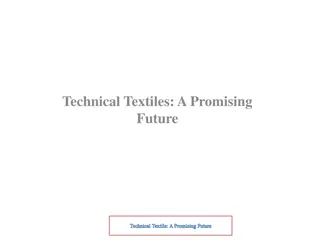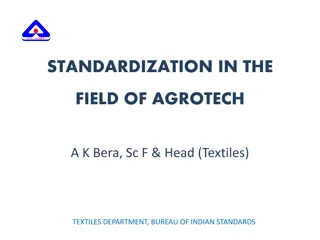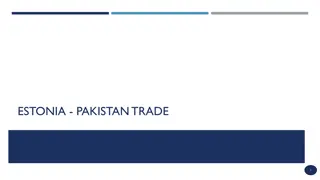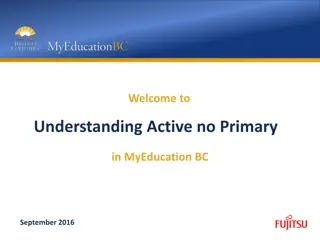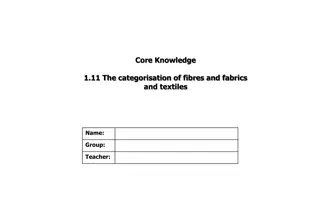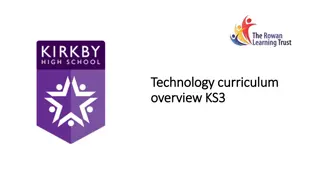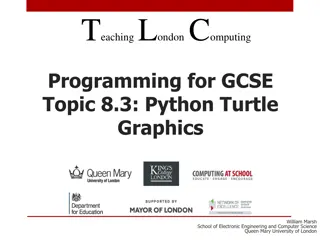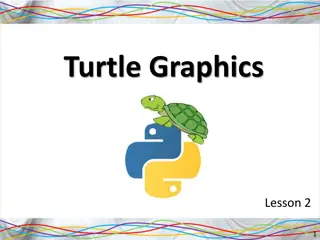Unlocking Creative Potential in 3D Design, Graphics, and Textiles for Primary School Students
Explore a comprehensive curriculum map for Year 7 and 8 students, guiding them through engaging rotations in 3D design, graphics, and textiles. From creating memo holders inspired by artists to designing logos for funky fruit juice bars, students develop key skills in woodworking, metalworking, typography, and more. Dive into projects like Islamic art jewelry boxes, magazine covers, and soft sculpture textiles, fostering creativity and technical proficiency in a safe learning environment.
Download Presentation

Please find below an Image/Link to download the presentation.
The content on the website is provided AS IS for your information and personal use only. It may not be sold, licensed, or shared on other websites without obtaining consent from the author.If you encounter any issues during the download, it is possible that the publisher has removed the file from their server.
You are allowed to download the files provided on this website for personal or commercial use, subject to the condition that they are used lawfully. All files are the property of their respective owners.
The content on the website is provided AS IS for your information and personal use only. It may not be sold, licensed, or shared on other websites without obtaining consent from the author.
E N D
Presentation Transcript
Design - 3D Design; Graphics Unlocking Creative Potential 2021/22 CURRICULUM MAP Rotation 1 - Sept - Nov Rotation 2 - Nov - Feb Rotation 3 - Feb - May Rotation 4 - May - July 3D Design Primary School Knowledge & Skills Memo stand - Resistant Materials Year 7 Limited, some have used a saw before with a bench hook. Students learn about the artist and illustrator Charley Harper and apply his style to their design to create a memo holder using a variety of materials and processes. Health & safety is key with students learning how to work safely in a workshop with wood and metal working tools. Other skills include; measuring accurately, finishing and shaping wood, shaping metal and learning basic functions of ICT program 2D Design . Students are also introduced to the design process; researching, designing, making and evaluation. Rotation 1 - Sept - Nov Rotation 2 - Nov - Feb Rotation 3 - Feb - May Rotation 4 - May - July Graphics Primary School Knowledge & Skills Funky Fruit Logo - Branding Year 7 Limited. Students have some knowledge of enterprise and basic skills such as drawing and rendering. Year 7 students are introduced to key Graphical concepts using a logo project: Funky Fruit juice bar. Students engage with all of the formal elements required to create a successful logo, including; typography, Image simplification, colour psychology and composition. Students are also introduced to the importance of these elements in the world of marketing and advertising. Students explore successful image, combination and typographic logos and take inspiration from for their own designs. Students are encouraged to make progress on their basic drawing, presentation and rendering skills. Short Rotation Long Rotation 3D Design 1 Sept - Oct 2 Oct - Nov 3 Nov - Jan 4 Jan - Feb 1 - Feb - July 2 - Feb - July Prior Knowledge & Skills from Yr7 Islamic art inspired laser cut jewellery box - Geometric construction Pewter cast jewellery - Metalwork Year 8 Filing and shaping a preformed metal shape. Using 2D Design to create simple flat cut out shapes. The design process. Students research Islamic pattern and design which they use to create design ideas for the jewellery box. Models are created out of card to make prototypes of their design ideas. 2D Design skills are developed to create a box pattern including lid and joints. Research and design a piece of jewellery to fit in the box made in the short rotation, using the Art Deco design movement as inspiration. Learn about casting metals using moulds/ casting sand. Design and make a mould for pewter casting. Learn how to finish and polish pewter. Short Rotation Long Rotation Graphics 1 Sept - Oct 2 Oct - Nov 3 Nov - Jan 4 Jan - Feb 1 - Feb - July 2 - Feb - July Prior Knowledge & Skills from Yr7 Tiger - Children s Book Illustration Ana Strumpf Magazine Cover - Graphic Design Year 8 Students have prior knowledge of marketing, advertising, colour psychology and Typography. They have also had teaching in the following elements: Presentation, composition, rendering and drawing. Students build on drawing and rendering skills via a project on children s book illustration. Work by children s book illustrators, Rob Biddulph and Oliver Jeffers are observed & analysed to progress their annotation skills. Students design their own childrens book character - The Tiger Who Came to Tea, learning to simplify and abstract from realistic images of tigers. Students then have time to progress their typographic skills with an emphasis on composition. Students study the Designer Ana Strumpf and create their own magazine front cover. Introducing IT and how to use google drawing students learn: drawing shapes, inserting appropriate typography, using a colour pallette and composition rules. Skills learnt include; the anatomy of a magazine cover, analysing photography, taking photos, design ideas and learning how to transfer their initial idea to a final finished digital piece.
Design - Textiles; Food & Nut Unlocking Creative Potential 2021/22 CURRICULUM MAP Rotation 1 - Sept - Nov Rotation 2 - Nov - Feb Rotation 3 - Feb - May Rotation 4 - May - July Textiles Primary School Knowledge & Skills Succulents - Soft Sculpture Textiles Year 7 Limited exposure to Textiles. Some students have basic embroidery skills, with few having used a sewing machine. Exploring the theme - Succulents with students making a fine art textiles illustration. An introduced to the design process of; research, analysis of artists, designing, sampling and making a final piece. Students build skills within; observational drawing, composition layout, annotation, explaining their opinions and shading using tone. Practical skills include; basic embroidery and a wide variety of stitches inspired by the textile artist Sue Spargo as well as professional presentation of their final piece. Rotation 1 - Sept - Nov Rotation 2 - Nov - Feb Rotation 3 - Feb - May Rotation 4 - May - July Food & Nut Primary School Knowledge & Skills Healthy Eating Year 7 Limited exposure. Group cooking or after school clubs. Some students are encouraged to cook at home. Students are taught how to work safely and hygienically around food in the kitchen. The Eatwell Guide and how it forms the basis of daily food intake. Students learn about different factors that would affect their food choices such as religion, health and age. Basic knife skills are taught, along with learning how to use an oven and hob safely with easy practical dishes. The variety of dishes encourages discussion about seasonality and changes to ingredients for different reasons. Short Rotation Long Rotation Textiles 1 Sept - Oct 2 Oct - Nov 3 Nov - Jan 4 Jan - Feb 1 - Feb - July 2 - Feb - July Prior Knowledge & Skills from Yr7 Weaving Landscapes - Constructed Textiles Day of the Dead - Soft Sculpture Textiles Year 8 This short project builds students understanding of the design process ready for GCSE. Students identify colour & pattern from the abstract landscape artist Barbara Rae and create their own landscape design. They learn a variety of weaving stitches and apply these to their final woven landscape piece. Students are introduced to the importance of the development of ideas. Building on the design process, students research Day of the Dead, and develop design ideas of Sugar Skulls inspired by the artist Sue Spargo. New skills learnt include; applique and advanced embroidery skills; to create a 3D soft sculptured sugar skull. After learning the design process and embroidery skills, students develop further textile techniques. Short Rotation Long Rotation Food & Nut 1 Sept - Oct 2 Oct - Nov 3 Nov - Jan 4 Jan - Feb 1 - Feb - July 2 - Feb - July Prior Knowledge & Skills from Yr7 The Science of Bread Making Healthy Eating Year 8 Safety and hygiene in the kitchen. Oven safety. This short project introduces the students to the idea that cooking isn t just about the food, but that there is science involved in some areas. We look at how yeast works in different conditions and how those conditions affect a finished bread product. Students are shown a basic recipe and are allowed to develop the recipe how they want to in order to make two final bread products. Building on year 7 knowledge and as a basic introduction to GCSE learning, students recap on the Eatwell guide and food choices. They will learn about food poisoning and prevention and where food comes from. Students will be given basic recipes, such as savoury mince, and the freedom to create dishes from the basic recipe, i.e chilli or bolognese.
Textiles KS4 Prior Knowledge & Skills from Year 8 Fine Art Textiles Illustration P1: Endangered Species Soft Sculpture House P2: Houses from around the world Students have built their confidence in hand embroidery & applique as well as an introduction to weaving and using the sewing machine safely. Students explore mixed media techniques, including; collage, applique, patchwork, inking and embroidery, inspired by a range of artists. Learning free machine embroidery skills on the sewing machine. The design process is embedded with greater emphasis on experimenting. Final solution of a textile illustrated animal. Students explore working from 2D to 3D to create a soft sculptured 3D house. Students research around their countries culture for design inspiration. A wide range of embellishment techniques explored with paper pattern making and construction techniques. Year 9 Prior Knowledge & Skills from Year 9 Printing - Repeat panel P3: Nature s Bounty MOCK EXAM 1 - 5hrs - Fine art textiles P4: Food Soft sculpture Doll P5: Wonderland After learning how to free machine and hand embellishing techniques, students are ready to develop these to a higher standard and learn further advanced techniques. Researching fruit and veg, students learn a variety of printing techniques to create samples. They learn how to create repeat patterns using CAD programs and how to layer shapes. Final solution is a personal repeated print panel. Students research the theme food and respond to a wide variety of artists to create textile experiments. Personal ideas are explored through 1st hand photography. Students then apply skills in hand and machine embroidery, applique, collage & inking to create their final food textile fine art solution Students explore Alice in Wonderland to create a soft sculptured doll. Skills developed include pattern cutting and construction as well as applying a range of techniques learnt so far to their designs. Wonderland characters are developed and a final character doll is created. Year 10 Prior Knowledge & Skills from Year 10 MOCK EXAM 2 - 10hrs - Embellished Dress P6: Wonderland Unit 1 Refinement DIRT Unit 2 ESA - Free choice technique Externally Set theme Pathways Afterwards Extra Curricular Opportunities Knitting & Stitching Show visit Costume club for school production Competition (local and national) entry (all years) Online Twitter gallery to celebrate achievement (all years) Stretch and Challenge group Term 2 (Y7-8) Coursework Cafe (Y11) Term 3 Community artwork involvement Free machining and embellishment techniques are developed further with more advanced techniques. The design process is embedded. Students have the knowledge to be more independent with their choices. Students learn a range of embellishment and fabric manipulation techniques, inspired by fashion and textile artists. Students apply their own choice of textile techniques learnt across the whole course to create a final fashion solution. Skills also covered include; pattern cutting and garment making. Students have this period of time in lessons to improve all coursework and final pieces. Coursework Cafe is also held afterschool once a week to access materials during January. Students are set a theme from the exam board and follow the design process to develop their own response. Final solutions can include; print, 3D sculpture, fine art textiles or fashion. A Level in Textiles or in another visual arts specialism. Year 11 UAL Level 1 Diploma in Art, Design & Media at Abingdon & Witney College Careers include; fashion designer, buyer, graphic design, costume & theatre design, theatre make-up, photographer, textile designer
3D Design KS4 Prior Knowledge & Skills from Year 8 Phone stand P1: 50s Space race Pull along Wooden Toy P2: Animals USB Lamp P3: Organic forms 2D Design Research pages and annotation Creating designs from research Students explore card as a material to make products from and make a phone stand with a 1950s space race theme, learning to use the design process and exam board requirements. Students learn about toy safety requirement (legal and moral) and increase their woodworking hand skills, learning to use new tools, such as a coping saw, materials, like leather and hardwoods and techniques. They also increase their knowledge on how to produce an original design and a high quality finish. Students learn about electrical circuits and soldering make a simple circuit with an LED output. They continue to develop their design skills making a cover for the circuit based on organic forms aimed at a particular target market. They also include materials experimentation and their impact on the environment in their first course work project. Year 9 Prior Knowledge & Skills from Year 9 Bee House P4: National Trust Mock exam 1: Shadow puppet theatre P5: Chinese folk story Year 10 Creating Research pages and annotating them fully. Creating and designing from relevant research. The process of developing and refine a unique design. Students research lone bees and their needs and explore the environmental issues surrounding the bee populations. They develop an awareness of customer requirements while designing and making their second coursework project a bee house aimed to be sold in a National trust shop. Students research Balinese puppet culture and design and make a shadow puppet theatre for a performance of a Chinese folk story. They develop new skills while having to consider how space and light can be used effectively. This is their third coursework project and mock exam. Extra Curricular Opportunities Prior Knowledge & Skills from Year 10 MOCK EXAM 2 - 10hrs - Architecture P6: Micro/macro Unit 1 Refinement DIRT Unit 2 ESA - Free choice technique Externally Set theme Pathways Afterwards Design plus club Competition (local and national) entry (all years) Online Twitter gallery to celebrate achievement (all years) Stretch and Challenge group Term 2 (Y7-8) Coursework Cafe (Y11) Term 3 Community artwork involvement Clear understanding of the stages in the design process. Hand working skills and computer making skills. Students design and make a model of a building with a purpose or theme, researching Architects and architecture to help inform their design choices. They consider what makes a good building and how a building is part of its surroundings and community. Students have this period of time in lessons to improve all coursework and final pieces. Coursework Cafe is also held after school once a week to access materials during January. Students respond to a theme provided by the exam board to design and make a product or model. ?A Level in Product Design or in another visual arts specialism. Year 11 UAL Level 1 Diploma in Art, Design & Media at Abingdon & Witney College Careers include; product designer, engineer, architect, carpenter, model maker, interior design.
Graphics KS4 Prior Knowledge & Skills from Year 8 Graphic illustration P1: Typography as art Collage design P2: Vintage (Eduado Recife) Students have built their understanding of designing to a brief, illustration techniques, colour psychology, composition. Students explore the use of typography as an artform as well as a communication tool. Students will use the influence of renowned typographers to create typographic compositions using a range of materials and techniques. Students use experimental techniques and combine it with their own photography and illustrations to design a piece of packaging. Students will understand the need for a brief and how to work to the needs of a specific target audience. Students will learn the basic rules of composition and graphic design through the medium of collage and digital collage. They will learn to design a poster to highlight their chosen social issue to explore how design can be used to affect social change. Student will have the opportunity to learn some of the functions of Adobe Photoshop and their final design will be an A3 poster. Year 9 Prior Knowledge & Skills from Year 9 Editorial design P3: Pop Icons (Raygun magazine) MOCK EXAM 1 - 5hrs - Book Cover Design P4: Graphic Communication Logo design P5: Festivals Students have a good understanding of composition and the basic rules of design. Students will have a beginners understanding of Adobe Photoshop and will have started to take photographs for design use. Students will understand how to design using a grid and how to break the rules of design to create really creative editorial design in the style of RayGun magazine, students will look at the iconic designers David Carson and Chris Ashworth. Students will take their own photographs to use in their magazine spreads. They will also explore creative typography to communicate the theme of their magazine article. Students use a given theme to explore. They will then research the use of illustrators to influence their design ideas and develop an illustrated book cover. Students will have the opportunity to explore how typography is used in book cover design and how to interpret a story through a cover design. Students will start their Festival project in year 10 and this will continue through to yr 11. This first section of the project will see students researching logo design and developing a logo for their festival to appear on their posters and merchandise. Students will follow the design process to create a successful logo. Students will explore the use of typography and how to turn an image into an icon. Students will also learn how to use Adobe Illustrator. Year 10 Prior Knowledge & Skills from Year 10 MOCK EXAM 2 - 10hrs - P6: Festivals Unit 1 Refinement DIRT Unit 2 ESA - Free choice technique Externally Set theme Pathways Afterwards Extra Curricular Opportunities Students should have confident skills using photoshop and some illustrator. They will have a good understanding of using typography and photography to communicate visually. Students will create the advertising and merchandise for a festival of their own choice. Students will have the opportunity to create their own brief and design to their interests. Students will also have the opportunity to choose their own design influences to support their experiments and design development. Students have this period of time in lessons to improve all coursework and final pieces. Coursework Cafe is also held after school once a week to access materials during January. Students are set a theme from the exam board and follow the design process to develop their own response. Final solutions can include; packaging, editorial design, poster, book cover, information graphics, illustration. A Level in Graphic Design or in another visual arts specialism. Competition (local and national) entry (all years) Online Twitter gallery to celebrate achievement (all years) Stretch and Challenge group Term 2 (Y7-8) Coursework Cafe (Y11) Term 3 Community artwork involvement Year 11 UAL Level 1 Diploma in Art, Design & Media at Abingdon & Witney College Careers include; Graphic designer, illustrator, advertising art director, animator, artworker, concept artist, creative director.
Hospitality and Catering KS4 Prior Knowledge & Skills from Year 8 Understand the environment in which Hospitality and Catering providers operate. Unit 1. Term 1-2 Know how food can cause ill health. Unit 1. Term 3-4 Understand how Hospitality and Catering provision operates. Unit 1. Term 5-6 Students have built their confidence in the kitchen and working within a limited time frame. Basic health and hygiene in the kitchen. Healthy eating and food choices. Students will learn about the structure of the Hospitality and Catering industry, job requirements within the industry, working conditions of different job roles across the industry and factors which affect the success of Hospitality and Catering providers. Students will Research food related causes of ill health, the role and responsibilities of the environmental health officer, food safety legislation, common types of food poisoning and the symptoms of food poisoning. Students will learn about the operation of different areas of Hospitality and Catering providers such as the kitchen and front of house . Students will research how Hospitality and Catering provision adapts to meet customer requirements. Year 9 Ongoing practical skills: Students will develop their techniques, cooking methods and presentation skills. Students will build on their confidence to produce dishes independently and making choices according to their skill level. Prior Knowledge & Skills from Year 9 Understand how Hospitality and Catering provision meets health and safety requirements. Unit 1. Term 1-2 Understanding the importance of Nutrition when planning menus. Unit 2. Term 3-4 Revision. Mock written exam. March Propose provisions to meet specific needs. Unit 1 MOCK NEA ASSESSMENT. Term 5-6 Students skills and confidence continuing to develop and learn higher skill dishes in practical lessons. Students will learn about risks to personal safety in Hospitality and Catering, the control measures needed for personal safety and the legal requirements for Hospitality providers. Students will learn how to describe the functions of nutrients in the body, compare the nutritional needs of specific groups of people, Students will be able to explain the characteristics of unsatisfactory nutritional intake Revision of Unit 1. Internally marked Students will learn how to review and recommend options for Hospitality and Catering provision to meet specific consumer needs. Mock Non Exam Assessment with 3 hour mock practical session. Year 10 Ongoing practical skills: Students will develop their techniques, cooking methods and presentation skills. Students will build on their confidence to produce dishes independently and making choices according to their skill level. Prior Knowledge & Skills from Year 10 Understand menu planning. Unit 2. Term 1-2 Non Exam Assessment 60%. Term 3-4 Written exam 40% Term 5 Pathways After GCSE Apprenticeships with full time work. Building on the mock NEA understanding, and developing research skills ready for final NEA. Continuing to learn high level skills for final practical exam Students will be able to explain things to consider when proposing dishes for a menu and explain how they meet customer needs. Students will research environmental issues affect their menu choices when planning the production of a menu. Internally assessed exam and coursework that is a culmination of the Unit 2 learning. Students will use their knowledge and learning in order to carry out preparation, cooking and presentation of nutritional dishes in a 3 hour practical exam. Externally marked written paper that will assess Unit 1 knowledge and understanding. Year 11 Professional Culinary Arts course at City of Oxford College. University courses in Hospitality Management or Culinary Arts. Ongoing practical skills: Students will develop their techniques, cooking methods and presentation skills. Students will build on their confidence to produce dishes independently and making choices according to their skill level.
